2010 CHEVROLET CORVETTE child seat
[x] Cancel search: child seatPage 70 of 472
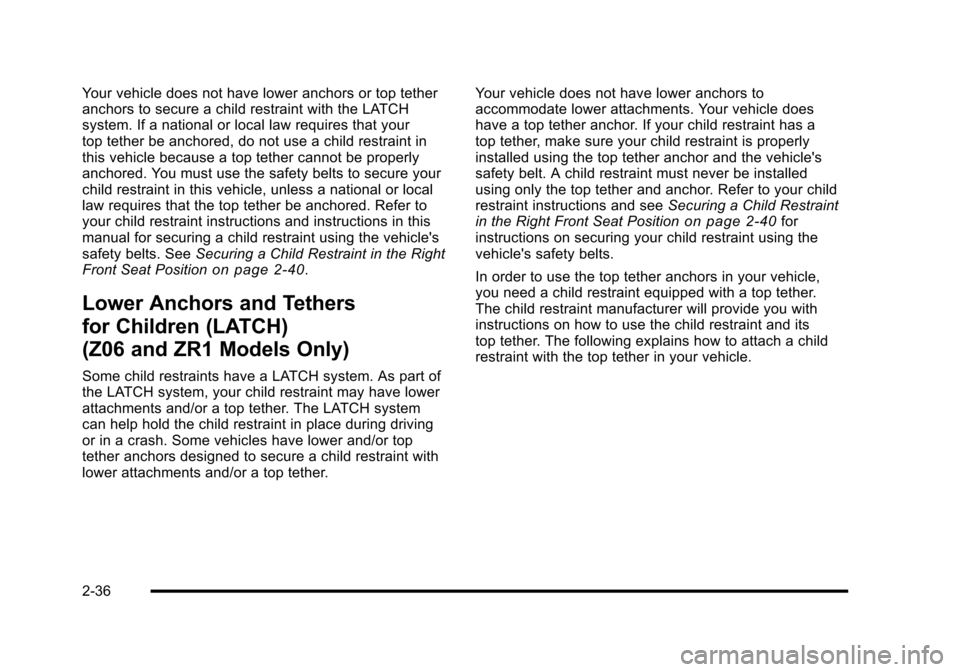
Your vehicle does not have lower anchors or top tether
anchors to secure a child restraint with the LATCH
system. If a national or local law requires that your
top tether be anchored, do not use a child restraint in
this vehicle because a top tether cannot be properly
anchored. You must use the safety belts to secure your
child restraint in this vehicle, unless a national or local
law requires that the top tether be anchored. Refer to
your child restraint instructions and instructions in this
manual for securing a child restraint using the vehicle's
safety belts. See Securing a Child Restraint in the Right
Front Seat Position
on page 2‑40.
Lower Anchors and Tethers
for Children (LATCH)
(Z06 and ZR1 Models Only)
Some child restraints have a LATCH system. As part of
the LATCH system, your child restraint may have lower
attachments and/or a top tether. The LATCH system
can help hold the child restraint in place during driving
or in a crash. Some vehicles have lower and/or top
tether anchors designed to secure a child restraint with
lower attachments and/or a top tether. Your vehicle does not have lower anchors to
accommodate lower attachments. Your vehicle does
have a top tether anchor. If your child restraint has a
top tether, make sure your child restraint is properly
installed using the top tether anchor and the vehicle's
safety belt. A child restraint must never be installed
using only the top tether and anchor. Refer to your child
restraint instructions and see
Securing a Child Restraint
in the Right Front Seat Position
on page 2‑40for
instructions on securing your child restraint using the
vehicle's safety belts.
In order to use the top tether anchors in your vehicle,
you need a child restraint equipped with a top tether.
The child restraint manufacturer will provide you with
instructions on how to use the child restraint and its
top tether. The following explains how to attach a child
restraint with the top tether in your vehicle.
2-36
Page 73 of 472
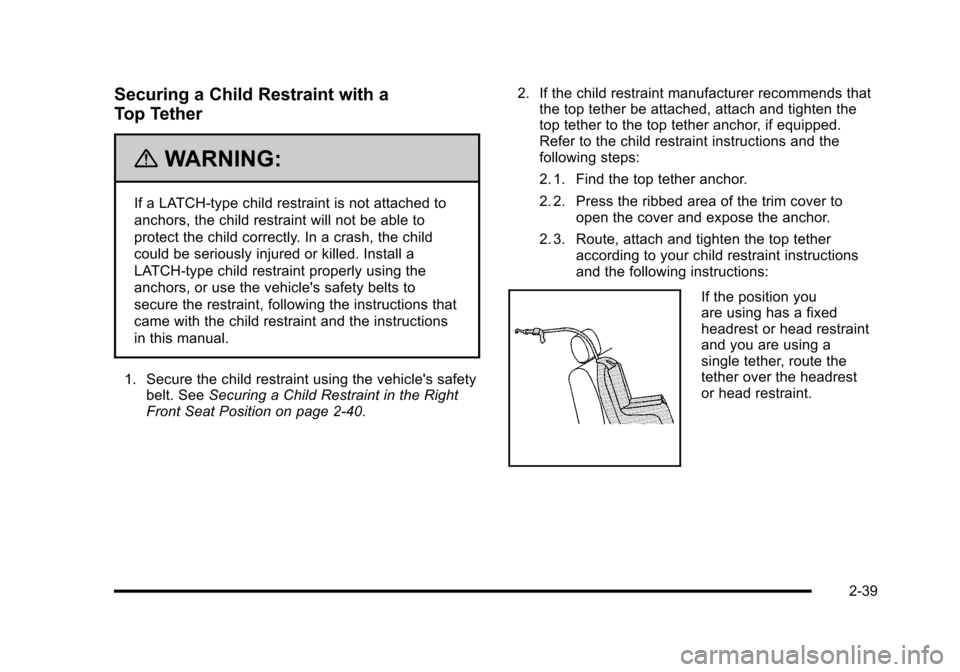
Securing a Child Restraint with a
Top Tether
{WARNING:
If a LATCH-type child restraint is not attached to
anchors, the child restraint will not be able to
protect the child correctly. In a crash, the child
could be seriously injured or killed. Install a
LATCH-type child restraint properly using the
anchors, or use the vehicle's safety belts to
secure the restraint, following the instructions that
came with the child restraint and the instructions
in this manual.
1. Secure the child restraint using the vehicle's safety belt. See Securing a Child Restraint in the Right
Front Seat Position on page 2‑40. 2. If the child restraint manufacturer recommends that
the top tether be attached, attach and tighten the
top tether to the top tether anchor, if equipped.
Refer to the child restraint instructions and the
following steps:
2. 1. Find the top tether anchor.
2. 2. Press the ribbed area of the trim cover to
open the cover and expose the anchor.
2. 3. Route, attach and tighten the top tether according to your child restraint instructions
and the following instructions:
If the position you
are using has a fixed
headrest or head restraint
and you are using a
single tether, route the
tether over the headrest
or head restraint.
2-39
Page 74 of 472
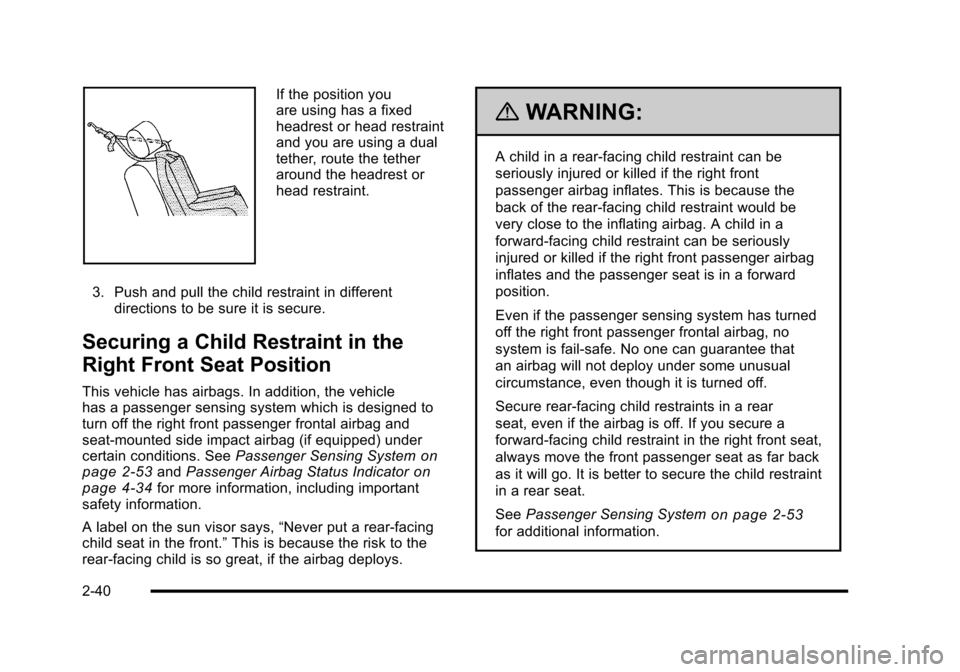
If the position you
are using has a fixed
headrest or head restraint
and you are using a dual
tether, route the tether
around the headrest or
head restraint.
3. Push and pull the child restraint in different directions to be sure it is secure.
Securing a Child Restraint in the
Right Front Seat Position
This vehicle has airbags. In addition, the vehicle
has a passenger sensing system which is designed to
turn off the right front passenger frontal airbag and
seat-mounted side impact airbag (if equipped) under
certain conditions. See Passenger Sensing System
on
page 2‑53and Passenger Airbag Status Indicatoron
page 4‑34for more information, including important
safety information.
A label on the sun visor says, “Never put a rear-facing
child seat in the front.” This is because the risk to the
rear-facing child is so great, if the airbag deploys.
{WARNING:
A child in a rear-facing child restraint can be
seriously injured or killed if the right front
passenger airbag inflates. This is because the
back of the rear-facing child restraint would be
very close to the inflating airbag. A child in a
forward-facing child restraint can be seriously
injured or killed if the right front passenger airbag
inflates and the passenger seat is in a forward
position.
Even if the passenger sensing system has turned
off the right front passenger frontal airbag, no
system is fail-safe. No one can guarantee that
an airbag will not deploy under some unusual
circumstance, even though it is turned off.
Secure rear-facing child restraints in a rear
seat, even if the airbag is off. If you secure a
forward-facing child restraint in the right front seat,
always move the front passenger seat as far back
as it will go. It is better to secure the child restraint
in a rear seat.
See Passenger Sensing System
on page 2‑53
for additional information.
2-40
Page 75 of 472
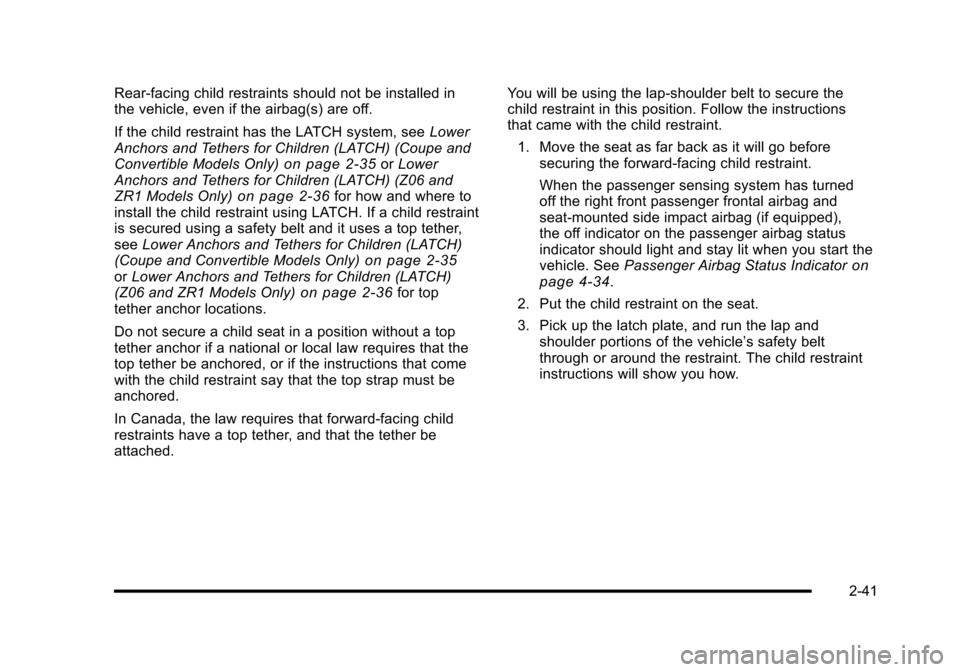
Rear-facing child restraints should not be installed in
the vehicle, even if the airbag(s) are off.
If the child restraint has the LATCH system, see Lower
Anchors and Tethers for Children (LATCH) (Coupe and
Convertible Models Only)
on page 2‑35or Lower
Anchors and Tethers for Children (LATCH) (Z06 and
ZR1 Models Only)
on page 2‑36for how and where to
install the child restraint using LATCH. If a child restraint
is secured using a safety belt and it uses a top tether,
see Lower Anchors and Tethers for Children (LATCH)
(Coupe and Convertible Models Only)
on page 2‑35or Lower Anchors and Tethers for Children (LATCH)
(Z06 and ZR1 Models Only)on page 2‑36for top
tether anchor locations.
Do not secure a child seat in a position without a top
tether anchor if a national or local law requires that the
top tether be anchored, or if the instructions that come
with the child restraint say that the top strap must be
anchored.
In Canada, the law requires that forward-facing child
restraints have a top tether, and that the tether be
attached. You will be using the lap-shoulder belt to secure the
child restraint in this position. Follow the instructions
that came with the child restraint.
1. Move the seat as far back as it will go before securing the forward-facing child restraint.
When the passenger sensing system has turned
off the right front passenger frontal airbag and
seat-mounted side impact airbag (if equipped),
the off indicator on the passenger airbag status
indicator should light and stay lit when you start the
vehicle. See Passenger Airbag Status Indicator
on
page 4‑34.
2. Put the child restraint on the seat.
3. Pick up the latch plate, and run the lap and shoulder portions of the vehicle’s safety belt
through or around the restraint. The child restraint
instructions will show you how.
2-41
Page 79 of 472
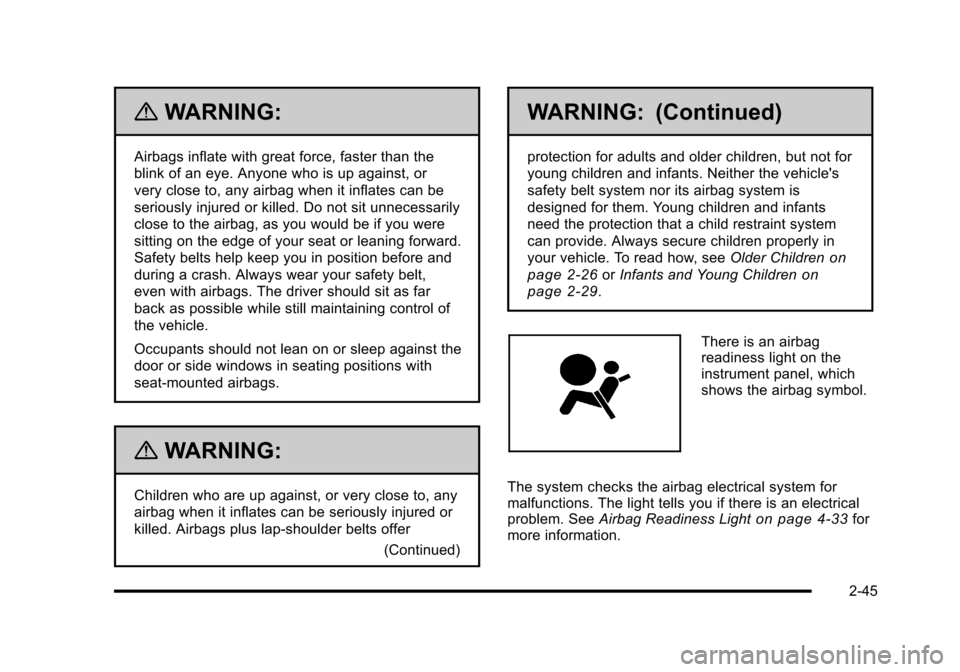
{WARNING:
Airbags inflate with great force, faster than the
blink of an eye. Anyone who is up against, or
very close to, any airbag when it inflates can be
seriously injured or killed. Do not sit unnecessarily
close to the airbag, as you would be if you were
sitting on the edge of your seat or leaning forward.
Safety belts help keep you in position before and
during a crash. Always wear your safety belt,
even with airbags. The driver should sit as far
back as possible while still maintaining control of
the vehicle.
Occupants should not lean on or sleep against the
door or side windows in seating positions with
seat-mounted airbags.
{WARNING:
Children who are up against, or very close to, any
airbag when it inflates can be seriously injured or
killed. Airbags plus lap-shoulder belts offer (Continued)
WARNING: (Continued)
protection for adults and older children, but not for
young children and infants. Neither the vehicle's
safety belt system nor its airbag system is
designed for them. Young children and infants
need the protection that a child restraint system
can provide. Always secure children properly in
your vehicle. To read how, see Older Children
on
page 2‑26
or Infants and Young Childrenon
page 2‑29
.
There is an airbag
readiness light on the
instrument panel, which
shows the airbag symbol.
The system checks the airbag electrical system for
malfunctions. The light tells you if there is an electrical
problem. See Airbag Readiness Light
on page 4‑33for
more information.
2-45
Page 87 of 472

Passenger Sensing System
The vehicle has a passenger sensing system for the
right front passenger position. The passenger airbag
status indicator will be visible in the rearview mirror
when the vehicle is started.
United States
Canada The words ON and OFF, or the symbol for on and off,
will be visible during the system check. When the
system check is complete, either the word ON or OFF,
or the symbol for on or off, will be visible. See
Passenger Airbag Status Indicator on page 4‑34.
The passenger sensing system will turn off the right
front passenger frontal airbag and seat-mounted side
impact airbag under certain conditions. The driver
airbags are not affected by the passenger sensing
system.
The passenger sensing system works with sensors
that are part of the right front passenger seat.
The sensors are designed to detect the presence of
a properly-seated occupant and determine if the right
front passenger frontal airbag and seat-mounted side
impact airbag should be enabled (may inflate) or not.
According to accident statistics, children are safer when
properly secured in a rear seat in the correct child
restraint for their weight and size. We recommend that
rear-facing child restraints not be transported in the
vehicle, even if the airbags are off.
2-53
Page 88 of 472
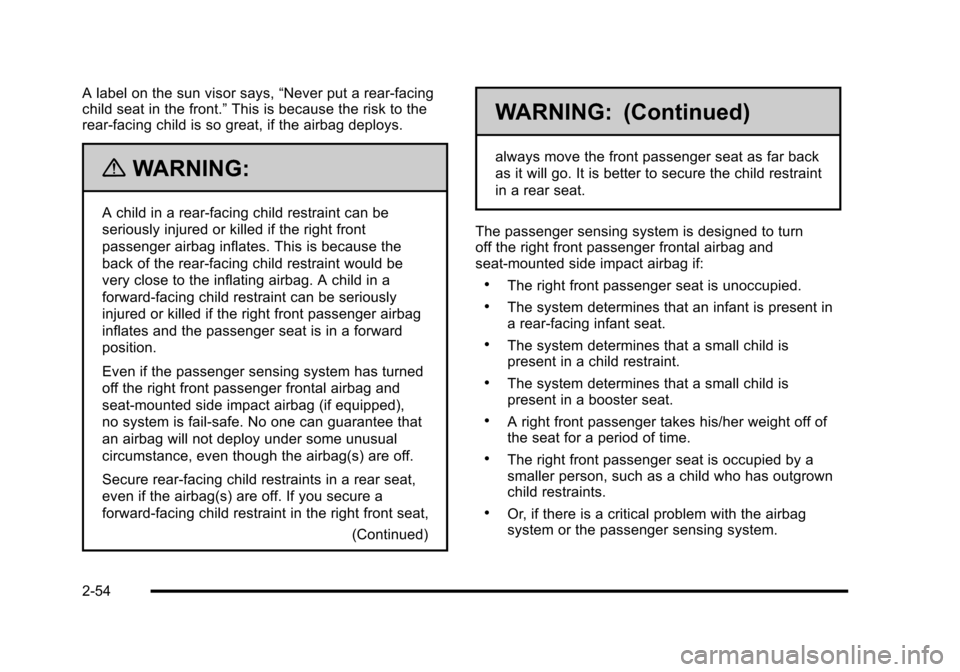
A label on the sun visor says,“Never put a rear-facing
child seat in the front.” This is because the risk to the
rear-facing child is so great, if the airbag deploys.
{WARNING:
A child in a rear-facing child restraint can be
seriously injured or killed if the right front
passenger airbag inflates. This is because the
back of the rear-facing child restraint would be
very close to the inflating airbag. A child in a
forward-facing child restraint can be seriously
injured or killed if the right front passenger airbag
inflates and the passenger seat is in a forward
position.
Even if the passenger sensing system has turned
off the right front passenger frontal airbag and
seat-mounted side impact airbag (if equipped),
no system is fail-safe. No one can guarantee that
an airbag will not deploy under some unusual
circumstance, even though the airbag(s) are off.
Secure rear-facing child restraints in a rear seat,
even if the airbag(s) are off. If you secure a
forward-facing child restraint in the right front seat,
(Continued)
WARNING: (Continued)
always move the front passenger seat as far back
as it will go. It is better to secure the child restraint
in a rear seat.
The passenger sensing system is designed to turn
off the right front passenger frontal airbag and
seat-mounted side impact airbag if:
.The right front passenger seat is unoccupied.
.The system determines that an infant is present in
a rear-facing infant seat.
.The system determines that a small child is
present in a child restraint.
.The system determines that a small child is
present in a booster seat.
.A right front passenger takes his/her weight off of
the seat for a period of time.
.The right front passenger seat is occupied by a
smaller person, such as a child who has outgrown
child restraints.
.Or, if there is a critical problem with the airbag
system or the passenger sensing system.
2-54
Page 89 of 472
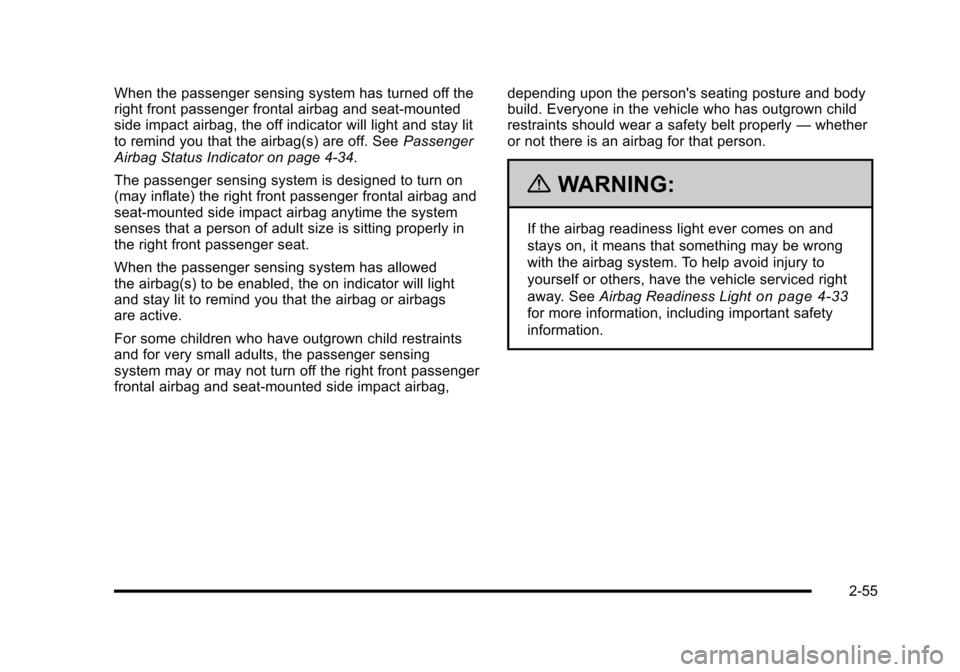
When the passenger sensing system has turned off the
right front passenger frontal airbag and seat-mounted
side impact airbag, the off indicator will light and stay lit
to remind you that the airbag(s) are off. See Passenger
Airbag Status Indicator on page 4‑34.
The passenger sensing system is designed to turn on
(may inflate) the right front passenger frontal airbag and
seat-mounted side impact airbag anytime the system
senses that a person of adult size is sitting properly in
the right front passenger seat.
When the passenger sensing system has allowed
the airbag(s) to be enabled, the on indicator will light
and stay lit to remind you that the airbag or airbags
are active.
For some children who have outgrown child restraints
and for very small adults, the passenger sensing
system may or may not turn off the right front passenger
frontal airbag and seat-mounted side impact airbag, depending upon the person's seating posture and body
build. Everyone in the vehicle who has outgrown child
restraints should wear a safety belt properly
—whether
or not there is an airbag for that person.
{WARNING:
If the airbag readiness light ever comes on and
stays on, it means that something may be wrong
with the airbag system. To help avoid injury to
yourself or others, have the vehicle serviced right
away. See Airbag Readiness Light
on page 4‑33
for more information, including important safety
information.
2-55